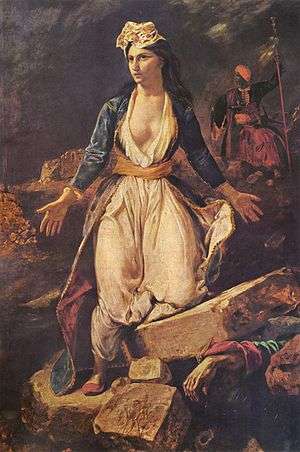Third Siege of Missolonghi
| Third Siege of Missolonghi | |||||||
|---|---|---|---|---|---|---|---|
| Part of the Greek War of Independence | |||||||
 Greece Expiring on the Ruins of Missolonghi (1827, Musée des Beaux-Arts, Bordeaux) | |||||||
| |||||||
| Belligerents | |||||||
|
|
| ||||||
| Commanders and leaders | |||||||
|
|
| ||||||
| Strength | |||||||
| 5,000 |
20,000 Ottomans 15,000 Ottoman auxiliaries ca. 15,000 Egyptians | ||||||
| Casualties and losses | |||||||
| 8,000+ soldiers and civilians | Unknown | ||||||

The Third Siege of Missolonghi (Greek: Τρίτη Πολιορκία του Μεσσολογίου, often erroneously referred to as the Second Siege) was fought in the Greek War of Independence, between the Ottoman Empire and the Greek rebels, from 15 April 1825 to 10 April 1826. The Ottomans had already tried and failed to capture the city in 1822 and 1823, but returned in 1825 with a stronger force of infantry and a stronger navy supporting the infantry. The Greeks held out for almost a year before they attempted a mass breakout, which however resulted in a disaster, with the larger part of the Greeks slain.

Prelude
Missolonghi was first besieged by the Ottomans in 1822, then in 1823. In April 1824, Lord Byron died in Missolonghi of an illness, adding to the fame of the city.
Siege
In spring 1825, the Ottomans came to besiege the Greeks again. The commander of the Ottomans, Reşid Mehmed Pasha was joined early 1826 by Ibrahim Pasha who crossed the Gulf of Corinth. During the early part of 1826, Ibrahim had more artillery and supply brought in. However, his men were unable to storm the walls. The High Commissioner of the Ionian Islands, Sir Frederick Adam, tried to make both forces sign a treaty, but his efforts were unsuccessful. The Greek Admiral Andreas Miaoulis kept breaking through the Ottoman naval blockade and bringing in supplies. However, when the Ottomans captured the fortress island of Anatolikon, Miaoulis was not able to bring in supplies.
Sortie
The situation soon became desperate for the defenders. After around a year of holding out the leaders of the Greeks, Notis Botsaris, Kitsos Tzavelas and Makris made a plan to escape the city. When all food supplies had run out and there was no hope of relief, the besieged Greeks decided that some of the menfolk of fighting age should burst out of the gates and attempt to lead the women and children to safety, while the rest would remain to defend the town to the death. Georgios Karaiskakis would attack the Turks from the rear and create a diversion while the besieged Greeks would escape the city. Of the 9,000 inhabitants only 7,000 were strong enough to take part.
The Turks had been made aware of the escape plan. When the refugees charged out of the city gates they were fired upon by Turks and Egyptians from defensive positions. Many of the Greeks panicked and fled inside the walls. Of the 7,000 people that tried to escape only 1,000 made it to safety. The next morning Palm Sunday the Turks entered the city. Many of the Greeks killed themselves by blowing themselves up with gunpowder rather than surrender. The rest were slaughtered or sold into slavery. The Turks displayed 3,000 severed heads off the walls.
Aftermath
Though a military disaster, the siege and its aftermath proved a victory for the Greek cause, and the Ottomans paid dearly for their harsh treatment of Missolonghi. After this incident, many people from Western Europe felt increased sympathy for the Greek cause, as manifested for example in the famous Delacroix painting Greece Expiring on the Ruins of Missolonghi (1827). The siege of Missolonghi also inspired Gioacchino Rossini's opera Le siège de Corinthe.
This public sympathy for the Greeks had a significant influence on the eventual decision of Britain, France and Russia to intervene militarily in the Battle of Navarino and secure Greece's independence - with the result that, among other things, within four years Missolonghi fell into Greek hands again.
The unfinished poem The Free Besieged by Dionysios Solomos is dedicated to the siege. Victor Hugo’s poem ‘’Les Têtes du sérail’’ from his ‘’Les Orientales’’ (1829) celebrates the Greek heroes of the siege. The siege is referenced in the ALPHA 60 song Ruins of Missolonghi.
See also
Sources
- Paroulakis, Peter Harold. The Greeks: Their Struggle for Independence. Hellenic International Press, 1984. ISBN 0-9590894-0-3.
Coordinates: 38°22′06″N 21°25′42″E / 38.36833°N 21.42833°E